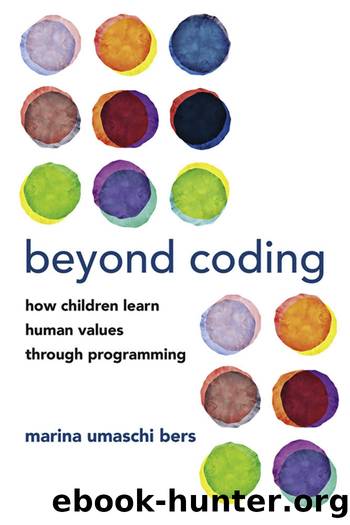Beyond Coding by Marina Umaschi Bers

Author:Marina Umaschi Bers [Bers, Marina Umaschi]
Language: eng
Format: epub
Tags: Early childhood education; coding; robotics; character education; moral education; computer science education; kindergarten; teachers; professional development; literacy
Publisher: MIT Press
Published: 2022-02-11T00:00:00+00:00
Figure 5.4
Wild rumpus characters created by Norfolk teachers
In addition to the one-day professional development, prior to working with their students, teachers had multiple opportunities for ongoing professional learning. This consisted of lesson slide decks, video tutorials, coaching calls with my DevTech team, and additional in-person support provided by the districtâs instructional technology resource technicians.
While some teachers were more successful than others, all of the schools were able to complete the implementation of the CAL-KIBO curriculum, approximately twice a week for a period spanning six to eight weeks. Naturally, the more advanced lessons in the curriculum were more difficult and time-consuming. Teachers who were successful in completing them consistently met with their colleagues to discuss plans, took advantage of opportunities to practice with KIBO on their own, and were able to adapt the lessons to serve the needs of their own students. The teachers who struggled would have benefited from more time spent on training, developing their own KIBO skills, and taking advantages of the provided resources. Teachers who had many students with not enough floor space for them to work on or had rigid grade-level schedules faced more challenging experiences.
During the CAL-KIBO project, we collected multiple types of data from teachers and students at various points in the curriculum. We used the data to answer the following research questions: How did our CAL-KIBO curriculum promote studentsâ coding and computational thinking skills? What is the relationship between studentsâ coding and computational thinking and their literacy and math skills? How did teachers react to KIBO and our CAL approach? What did teachers learn during the training and intervention? What factors impacted teachersâ ability to integrate coding into their classrooms? In the last chapter of this book, Resources, you can find a link to further readings and peer-reviewed publications with the findings.
Overall, students and teachers had a generally positive experience with CAL-KIBO. For many teachers, the hands-on nature of the robot was a welcomed addition to their classrooms. For example, Selma expressed âI learned that coding doesnât just involve sitting in front of a computer and typing things; it actually involves using your mind and talking things out.â Selma showed a great skill at integrating dance and movement into the CAL-KIBO curriculum. However, other teachers struggled with the logistics of so many tangible materials. Carla shared with us that âthings were messy, the KIBOs were in and out of the classroom, and things got mixed up, so I color-coded mine.â Carla complained that keeping track of the materials added more work for her.
The organization of KIBO blocks and modules presented its own set of challenges, particularly shifting materials between classrooms and managing clean-up time. Some teachers developed strategies such as creating a clear rotational system with fellow teachers, having select students in charge of KIBO clean-up, and keeping three to four KIBOs in their own classrooms at all times. For some, managing the KIBO materials was an opportunity to put into practice the palette of virtues; for others, it felt as if coding was just taking time away from teaching required content.
Download
This site does not store any files on its server. We only index and link to content provided by other sites. Please contact the content providers to delete copyright contents if any and email us, we'll remove relevant links or contents immediately.
Cecilia; Or, Memoirs of an Heiress — Volume 1 by Fanny Burney(32446)
Cecilia; Or, Memoirs of an Heiress — Volume 2 by Fanny Burney(31875)
Cecilia; Or, Memoirs of an Heiress — Volume 3 by Fanny Burney(31861)
The Great Music City by Andrea Baker(31550)
We're Going to Need More Wine by Gabrielle Union(18976)
All the Missing Girls by Megan Miranda(15604)
Pimp by Iceberg Slim(14403)
Bombshells: Glamour Girls of a Lifetime by Sullivan Steve(13983)
Talking to Strangers by Malcolm Gladwell(13238)
Norse Mythology by Gaiman Neil(13221)
Fifty Shades Freed by E L James(13165)
For the Love of Europe by Rick Steves(13155)
Mindhunter: Inside the FBI's Elite Serial Crime Unit by John E. Douglas & Mark Olshaker(9215)
Crazy Rich Asians by Kevin Kwan(9177)
The Lost Art of Listening by Michael P. Nichols(7413)
Enlightenment Now: The Case for Reason, Science, Humanism, and Progress by Steven Pinker(7244)
The Four Agreements by Don Miguel Ruiz(6643)
Bad Blood by John Carreyrou(6560)
Weapons of Math Destruction by Cathy O'Neil(6156)
